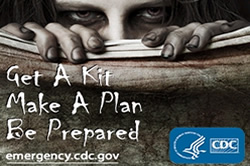May 27th, 2011 by Toni Brayer, M.D. in Health Policy, News
No Comments »

 The Center for Disease Control published the top ten public health achievements from 2001-2010, the first decade of the 21st century. In no order they are:
The Center for Disease Control published the top ten public health achievements from 2001-2010, the first decade of the 21st century. In no order they are:

- Vaccine-preventable Diseases – new vaccines for herpes zoster, pneumonia, HPV and rotavirus have saved thousands of lives When you add in the older vaccines for diptheria, pertussus, tetanus and measles/mumps millions of lives have been saved around the world. (I saw diptheria in Haiti and it is horrible)

- Tobacco Control- We have been battling tobacco since 1964 but there is finally progress with more states enacting smoke-free laws and raising cigarette taxes. By 2010, the FDA banned flavored cigarettes and established restrictions on youth access. We have a long way to go. Smoking costs us all about $193 billion a year on medical costs and loss of productivity.
- Motor Vehicle Safety –Enforcing seat belt and child safety legislation has reduced deaths from crashes. Teen drivers have new policies too.
- Cardiovascular Disease Prevention-During the past decade, age-adjusted heart disease and stroke deaths declined. What worked? Treating hypertension, elevated cholesterol and smoking…along with improved treatment and medication. Read more »
*This blog post was originally published at EverythingHealth*
May 26th, 2011 by Bryan Vartabedian, M.D. in Health Policy, Humor
No Comments »

 This is good. I knew the CDC was socially tuned-in but this came as a surprise: Preparedness 101: Zombie Apocalypse . It’s every American’s guide to dealing with a zombie attack. You come thinking zombies but take away principles for emergency preparedness. Well done, CDC.
This is good. I knew the CDC was socially tuned-in but this came as a surprise: Preparedness 101: Zombie Apocalypse . It’s every American’s guide to dealing with a zombie attack. You come thinking zombies but take away principles for emergency preparedness. Well done, CDC.
The real take away for those of us looking under the hood: effective health messaging should be creative and fun. While we’ll never be able to measure the true effectiveness of this approach in an emergency, expect the post’s massive traffic to convert important links on emergency preparedness. Hopefully the CDC will release stats on the effectiveness of this campaign.
I’d like to write more, but I’m goin’ to make my kit.
*This blog post was originally published at 33 Charts*
May 10th, 2011 by BarbaraFicarraRN in Health Tips
No Comments »

 Thanks to Laura Landro for shining light on unsafe injections in her WSJ blog, “Unsafe Injection Practices Persist Despite Education Efforts.”
Thanks to Laura Landro for shining light on unsafe injections in her WSJ blog, “Unsafe Injection Practices Persist Despite Education Efforts.”
Landro writes:
“A new push is underway to eliminate unsafe injection practices, which remain a persistent safety problem despite years of efforts to educate clinicians about the risks of re-using needles, syringes and drug vials.
In the U.S., failure to follow safe practices in delivering intravenous medications and injections has resulted in more than 30 outbreaks of infectious disease including hepatitis C, and the notification of more than 125,000 patients about potential exposure just in the last decade, according to health-care purchasing alliance Premier Inc.”
As a registered nurse this is unthinkable. Learning to administer injections safely is “patient care 101.” There is no excuse for any health care professional to unsafely inject patients.
Patients in the hospital, ambulatory surgical centers or outpatient settings, should expect that their nurses, doctors and other clinicians are administering injections safely. Read more »
*This blog post was originally published at Health in 30*
April 24th, 2011 by ChristopherChangMD in News, Research
No Comments »

It’s about TIME!!! I read this fascinating story on NPR here.
An all-natural insect repellant called nootkatone found in Alaska yellow cedar trees and citrus fruits (like grapefruit) is being developed by the CDC. It is so safe for humans, it is even an FDA-approved food additive.
Nootkatone is not only safe for humans and the environment, it is a highly effective insect repellant. In fact, it is not only a bug repellant, but an insecticide causing death to biting insects like mosquitoes within 15 seconds.
Application of 2% nootkatone will also control ticks for up to 42 days at greater than 97 percent efficacy.
It is non-greasy, dries very quickly, and it has a very pleasant, citrus-y grapefruit odor to it.
Sounds too good to be true… But it is true! The only downside right now is that it is not available in the market, mainly because it is expensive — $4,000 per kilogram for highly purified food-grade material, which is used in parts-per-million amounts as a flavoring agent.
However, there are two companies that are currently working to make it available as insect control, hopefully in the near future!
Read more about this here.
References:
Susceptibility of four tick species, Amblyomma americanum, Dermacentor variabilis, Ixodes scapularis, and Rhipicephalus sanguineus (Acari: Ixodidae), to nootkatone from essential oil of grapefruit. J Med Entomol. 2011 Mar;48(2):322-6.
Mode of action for natural products isolated from essential oils of two trees is different from available mosquito adulticides. J Med Entomol. 2010 Nov;47(6):1123-6.
Ability of two natural products, nootkatone and carvacrol, to suppress Ixodes scapularis and Amblyomma americanum (Acari: Ixodidae) in a Lyme disease endemic area of New Jersey. J Econ Entomol. 2009 Dec;102(6):2316-24.
Use of novel compounds for pest control: insecticidal and acaricidal activity of essential oil components from heartwood of Alaska yellow cedar. J Med Entomol. 2005 May;42(3):352-8.
*This blog post was originally published at Fauquier ENT Blog*
March 31st, 2011 by admin in Health Policy, Health Tips, Research
No Comments »

By Richard C. Hunt, MD, FACEP
Centers for Disease Control and Prevention
A 17 year-old athlete arrives on the sideline, at your office, or in the emergency department after hitting her head during a collision on the sports field and is complaining that she has a headache and “just doesn’t feel right.”
Can she return to play? If not, when can she safely return to school, sports, and to her normal daily activities? Does she need immediate care, a Head CT or MRI, or just some time to rest?
Do those questions sound familiar?
Each year thousands of young athletes present at emergency departments and in the primary care setting with a suspected sports- and recreation-related concussion. And every day, health care professionals, like us, are challenged with identifying and appropriately managing patients who may be at risk for short- or long-term problems.
As you know, concussion symptoms may appear mild, but this injury can lead to significant, life-long impairment affecting an individual’s ability to function physically, cognitively, and psychologically. Thus, appropriate diagnosis, referral, and education are critical for helping young athletes with concussion achieve optimal recovery and to reduce or avoid significant sequelae.
And that’s where you come in. Health care professionals play a key role in helping to prevent concussion and in appropriately identifying, diagnosing, and managing it when it does occur. Health care professionals can also improve patient outcomes by implementing early management and appropriate referral.
As part of my work at CDC, and as a health care professional, I am committed to informing others about CDC’s resources to help with diagnosing and managing concussion. CDC collaborated with several organizations and leading experts to develop a clinical guideline and tools for the diagnosis and management of patients with concussion, including:
For more information about the diagnosis and management of concussion, please visit www.cdc.gov/Concussion/clinician.html.
Also, learn more about CDC’s TBI activities and join the conversation at: www.facebook.com/cdcheadsup.
 The Center for Disease Control published the top ten public health achievements from 2001-2010, the first decade of the 21st century. In no order they are:
The Center for Disease Control published the top ten public health achievements from 2001-2010, the first decade of the 21st century. In no order they are:







 Thanks to Laura Landro for shining light on
Thanks to Laura Landro for shining light on 









